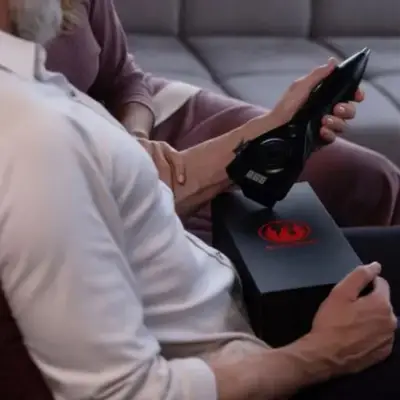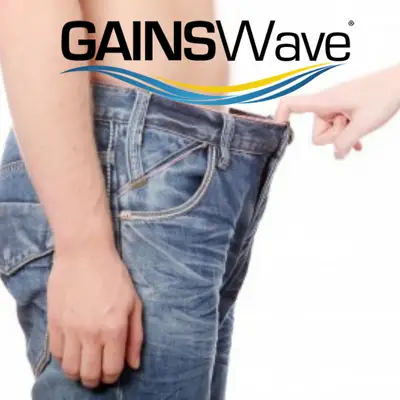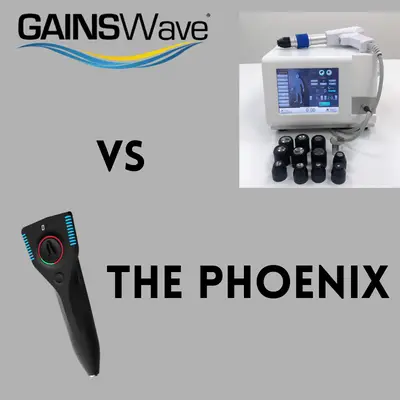Tendonitis in your Achilles is painful and downright torturous and the correct placement of a TENS unit electrode pad can help alleviate the suffering. Keep reading to find out how.
People are discovering non-traditional forms of pain management that do not involve pain medications. A TENS unit when used correctly is safe, effective and best of all it comes with no side effects. It is a cheap pain management alternative.
Where To Place TENS Electrode Pads For Achilles Tendonitis?

In order to get the most out of treating your tendonitis with a TENS unit the placement is going to be very important. As you can see in the picture you want to place one electrode pad just above your Achilles heal while the other pad is placed just below your calf. Once the pads are placed turn on your TENS unit.
There is some trial and error when it comes to the settings.
Start out on the lowest strength setting and see how it feels and increase the setting as needed. If you feel a strong twitch that means the setting is too high. You want to feel a gentle to modest tingling sensation. Using a TENS should never cause pain or discomfort. If you experience this turn the intensity level down!
Need to upgrade your TENS unit?
This is the exact TENS unit that I use. It is perfect for treating plantar fasciitis. The iReliev is a great little device and has a lot of going for it. It is under $80 and has several programs to choose from and is small enough to fit in your pocket.
You do not need to spend hundreds of dollars to get a quality TENS unit and iReliev gives you a ton of value for the price being paid. Best part is they are based in Dallas, Texas and have phenomenal customer service. Get yours today on the iReliev website by clicking here.

Why should you trust me?
I have extensively used TENS units for neck, shoulder, back and knee issues. I became familiar with TENS therapy through countless visits to my chiropractor and physical therapist’s office. I have spent many hours researching and reading how TENS therapy can alleviate pain.
I consider myself knowledgeable in the use of TENS units and have used them regularly to help manage pain over the years. Many of my recommendations are from firsthand experience/use and hopefully my information can be a benefit to you.
Want to know where else a TENS unit can be placed? Check out my TENS placement guide for how to use one for-
Knee Pain
Neck Pain
Shoulder Pain
Tension Headaches
Golfer’s Elbow
Plantar Fasciitis
Rotator Cuff Pain
Restless Leg Syndrome
OptimizeHealth365 tip- To get the most life out of your electrode pads always make sure to clean the skin where the TENS pad will be placed. The oils in your skin break down the gel on the pad and over time make the pad less sticky. Before placing the electrode use a baby wipe or a wet towel to remove any dirt/oil from the skin.
Alternative treatments that work for Achilles tendonitis
Let’s look at this holistically. Using a TENS unit can help your tendonitis but what other treatments/devices should you consider?
Supplement with turmeric curcumin with ginger. Why? Tendonitis in your Achilles heal is made worse by inflammation and by taking this supplement you can lower it. Get it for around $20 at Amazon. Click the link above for more information.
Ankle Brace Compression Sleeves– You can find several at Amazon for less than $20. These sleeves help with swelling and reduce the pain associated with tendinitis of the Achilles heal. The Techware Pro Ankle Sleeve is highly recommended and reviewed getting over a 4.5 star rating. Click the link to check it out.
What is Achilles Tendonitis?
The longest tendon in the body is also the strongest. The Achilles tendon is located on the lower leg and attaches to the heel bone. It seems simple enough when presented like that. But the Achilles tendon is an intricate band of tissue that connects calf muscles at the lower leg and the heel bone (calcaneus) to two calf muscles (soleus and gastrocnemius). Over the years, depending on much someone is on their feet, can put a lot of pressure on the tendons. Simple activities like walking or running can add stress to the Achilles tendon. Sometimes jumping or even dancing can cause small tears or inflammation in the tendons. If left untreated or warning signs are missed, people sometimes develop Achilles Tendonitis.
What can cause it Achilles tendonitis?
The cause of Achilles tendonitis is common in people who have spurts of minor sports activities in their middle-age. People, who spend weekends playing tennis, basketball, or even bowling, are at risk for developing the on-going injury.
Researchers find sudden increased activities involving the Achilles tendon are at highest risk of the problem. Repetitive movements can put stress on the feet and ankles, the infrequent act of athletics and individuals who are not conditioned for abrupt actions will experience difficulties in their ankles and calf muscles.
While rare cases are linked to degeneration at the site where the tendon attaches to the heel bone; this is a form of Achilles tendonosis.
Often Achilles tendonitis, the inflammation of the tendons, is usually short-lived. And with the right exercise and treatment, can reduce the problem or eliminate it altogether.
Sometimes overlooked as minimal muscle fatigue, Achilles tendonitis follows running or activities that involve a lot of leg movement. Pain associated with the problem starts at the leg of the leg, or just above the heel.
It can affect one leg or both legs.
Sometimes people experience stiffness and aching in the tendons in the morning. As the day progresses, the pain diminishes. Occasionally mild activities, such as stretching or walking slowing up and down stairs can help alleviate the tenderness.
What are the Symptoms associated with Achilles tendonitis?
They vary from acute pain and tenderness to swelling of the ankles. Most of the pain associated with the problem is localized along the tendon path.
People experience pain at the heel where the calf muscles attach to the bone and sometimes radiate up the back of the leg where the tendons run along the muscles. Often if this ache begins in the morning, it will likely subside or improve throughout the daily routine.
The tenderness associated with the problem comes with direct pressure to the tendons. If squeezed at the sides of the cords, it causes intense pain. However, when applying direct pressure to the back of the tendons, the tenderness sometimes subsides.
If someone is experiencing progressive degeneration, tendons can become enlarged, possibly develop nodules where there is damage to the tissue. If someone experiences symptoms associated with Achilles tendonitis, it is best to seek medical advice for a proper diagnosis.
Depending on how long someone experiences the problems or goes without proper treatment will have specific effects on how to appropriately treat Achilles tendonitis. If it is a short-term problem, with mild tenderness, aching, or minor swelling, the best course of action is stretching.
People who begin to experience Achilles tendonitis find they have fewer problems the more time they take in warming up or just staying active.
However, if there is acute inflammation, or sudden sharp pains when applying pressure to the feet or ankles, doctors recommend ice to reduce the swelling. A cotton towel between the skin and a bag of ice for 20 minutes on the affected area will significantly reduce inflammation.
Sometimes Nonsteroidal anti-inflammatory drugs, such as ibuprofen well aid in the early stages of the condition. Combining the ice and oral medication usually helps within a few hours of the onset.
If the condition worsens, where there are problems with gait abnormalities or overpronation, orthotic devices may help. Physical therapy, strengthening exercises, soft-tissue massaging, can significantly reduce the condition.
People who experience significant Achilles tendonitis are prescribed immobilization devices such as night splints to help stretch the tendon during regular sleep. Sometimes removable walking boots or casts are used to reduce mobility and promote healing to the ligaments.
Often people who need significant treatment will also go through a running and gait re-education for their tendons once the casts are removed. There is also ultrasound therapy available.
Surgery might be an option in extreme cases.
Most doctors experienced in treatment for Achilles tendonitis understand to find a list of nonsurgical approaches to restore normal conditions. Specialists who focus on ankle and foot procedures can help someone decide what the best option is when it comes to repairing tendons.
Much of the planning involved in the healing of the condition has to do with the patient’s age, the extent of the injuries, like ruptures or tearing, the activity levels, and other factors.
Most medical professionals will suggest its best to get ahead of the problem before the condition occurs. If someone feels they have the problem, there are a few simple steps to keeping ahead and staying healthy. And most people are on their feet all day.
We put a lot of pressure on our ankles and legs. Taking care of the Achilles’ tendons is essential.
What exercises can I do for Achilles Tendonitis?
Physical therapists recommend the best way to help you maintain healthy tendons are to stretch properly. There are a few simple stretches that are easy to do and won’t take all day.
If you find yourself sitting in a chair, you can put your heels on the floor and raise your toes as high as they go. The sitting heel raises are a great way to keep the tendons stretched and can be done anywhere.
Raising the toes and slowly lowering your feet again, done 20 times a day, will help your Achilles’ tendons.
Calf stretches are another great form of exercise for the whole leg.
Face a wall, put your hands flush on the wall and put one leg back while the other leg has a bent knee. The rear leg has the foot flat to the floor, while the forward leg is on the ball of your foot. Hold the position for 10 seconds and don’t allow your heel to come off the floor. Switch legs and do the opposite side. Try this for 20 times on each foot and make sure to relax while switching legs in a controlled manner.
Another great stretching exercise is the bilateral heel drop.
Use a raised platform or stairs; something that is stable and raised. Use something to support your weight and balance, place your feet, so the heels extend over the edge of the platform or stairs. While holding a railing or wall, allow slow movements up and down.
The position allows your legs to support your body weight. This should be down in a slow and controlled manner. Make sure if there is any fatigue on the calf muscles, to relax and work up to as many times as possible. Never do this exercise if your experience acute pain in the tendons. You can repeat the raise and lower of your body 20 times daily.
The unilateral heel drop is the same as the bilateral only done with one leg at a time. The same position as the bilateral exercise with identical handhold support while performing the task, but one leg allows you less weight each leg.
The ultimate goal of the exercises and the preparation for daily activities is to reduce the condition altogether.
To prevent injury or Achilles tendonitis stay active and always warm up before putting too much stress on your ankles and feet. Always wear the proper footwear designed for particular activities. Making sure footwear has adequate arch support is essential.
Often trendy athletic shoes look good but have no arch support. Daily exercise, stretching the calf muscles, and keeping a healthy and active lifestyle, even walking more, will significantly reduce the risk of Achilles tendonitis.
How long does it last?
If you experience pain around the ankle or swelling, don’t wait for it just to go away.
Sometimes the simple plan of resting the legs, proper footwear, with a little ice and oral over-the-counter medication can ease the pain. But it the condition persists, have it checked out immediately. Achilles tendonitis is a treatable and sometimes painful condition, and it can be confused with other injuries.
If discomfort persists more than a few days, and longer than a week, you should seek medical advice and see if you can get back on your feet before the acute inflammation causes you more than just a mild limp.
Recovery from short-term Achilles tendonitis is less expensive than a few trips to the doctor’s office. Take a moment, stretch, and stay active. The most important takeaway is to get it checked out just to be safe.
Thank you for reading






